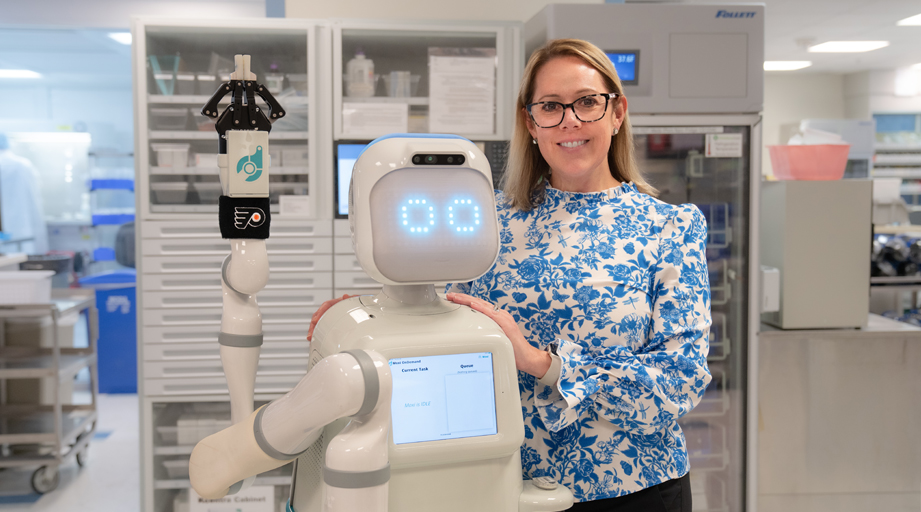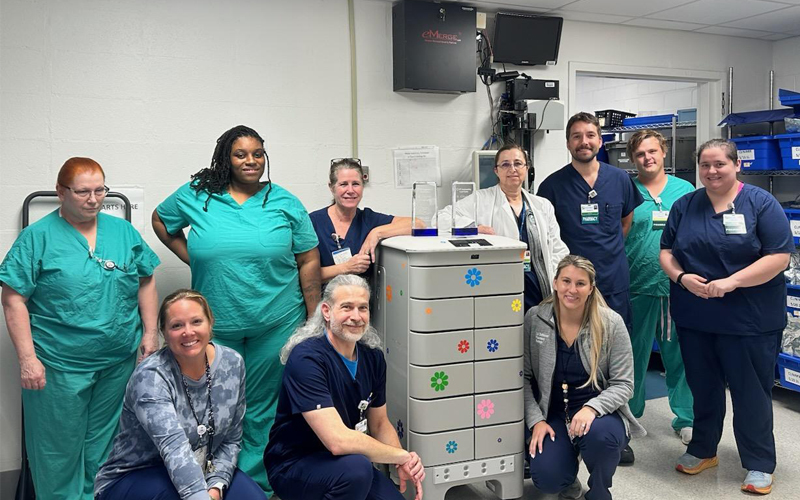
It's not uncommon for pharmacy technicians or staff members in a centralized hospital pharmacy department to periodically run out to deliver medications to patient care areas. Looking to keep all staff in the pharmacy operating at the top of their licensure, some hospitals have been turning to high-tech helpers for deliveries: robots.

A huge time saver
This summer, Dartmouth Hitchcock Medical Center in New Hampshire got three medication delivery robots. The decision was made after the COVID-19 pandemic caused a strain on staffing levels, causing pharmacy leaders to think of novel technologies to help, said Pranati Kuchimanchi, PharmD, the hospital’s lead clinical pharmacist for Medication Systems and Operations.
“We’ve been using them for ad hoc medication runs,” Kuchimanchi said, noting they primarily have the robots deliver tablets, creams, or ointments that should not be shaken. “We can’t store all the medications on the units, so certain medications must be delivered from our main pharmacy. We have a technician load those medications every time we have a dose due out on the floor that isn’t stocked there.”
Likening the robot to “a dresser or cabinet on wheels,” Kuchimanchi said the robots have several drawers of different sizes. A technician can program a robot to go to five hospital units, for example, punch in a code, and load medications in different drawers. The robot will then make its way to each hospital unit, where a nurse can punch in a code that opens drawers with medications designated for that area. When it finishes deliveries, the robot returns to a docking station located across the hall from the pharmacy.
“It has been a huge time saver for us,” said Kuchimanchi. The hospital just built two patient pavilion towers, and it would take a technician 15 minutes or so each way to deliver a medication from the pharmacy. “It’s hard to step away to deliver something and then come back and pick up that task again. It allows our staff to focus, and even frees up their time to take a break.”

Delivery assistance
Using robots to deliver medications is not a new concept. St. Elizabeth - Fort Thomas Hospital in Kentucky, a 188-bed community hospital, has employed a similar robot for medication deliveries for the past eight or so years, said ASHP member R.J. Frey, PharmD, the hospital’s pharmacy coordinator.
“This facility is about 70 years old, and we have a limited pneumatic tube just going to a few critical destinations – the lab, ER, ICU, and pharmacy,” Frey said. “It was going to be cost-prohibitive to add pneumatic tubes throughout the entire building, so this was something that enabled us to assist with getting medications delivered.”
Initially, the pharmacy used the robot to deliver most routine medications for hospitalized patients as the hospital was primarily on a cart fill distribution model at the time. As they transitioned more to using automated dispensing cabinets on the floors, the pharmacy now employs the robot to send some first doses or other medications as needed that aren’t in the cabinets. They also use it for most intravenous medication deliveries.
The hospital recently won two awards from the robot’s manufacturer for the device traveling the highest number of miles (2,059) and making the most deliveries (24,185) within a 12-month period.
“We try to send it pretty much as frequently as we can,” said Frey, noting his team appreciates that it has a tracking function that allows pharmacy team members to see when medications were delivered and who retrieved them. “The big thing for us is that it’s allowed us to keep an extra body in the department. Instead of that person being out walking around, just dropping off drugs, they can stay down here and do the physical tasks that a robot cannot do.”
Moxi delivers within 30 minutes
At ChristianaCare’s Christiana Hospital in Delaware, the pharmacy, nursing, and other departments share a different type of robot for deliveries called a collaborative robot, or “cobot.” Three robots have been roaming the halls of the 1,039-bed, 1.3 million-square-foot facility, performing some 7,000 pharmacy deliveries to date. The pharmacy has been the biggest user.
When pharmacy staff need a robot, called Moxi, they request it through an iPad function and program where it needs to go. Then, they can swipe an identification badge to open different-sized pockets and load medications. When the robot arrives on the units, it goes to a designated spot and dings to announce its arrival. The goal is to make deliveries within 30 minutes, said Shauna Vogl Porter, PharmD, director of inpatient pharmacy operations at Christiana Hospital.
“My team absolutely loves it,” said Porter, an ASHP member. “We primarily use it for medication delivery, so we focus on the non-tubeables and non-stat orders. The cobots augment my team and really allows them to be within the pharmacy satellites. Moxi has made the environment less chaotic and less stressful, and it has decreased the number of steps that my pharmacy technicians were doing to run these medications out.”
Besides the practical aspects of delivering medications, the robots make employees smile, pharmacists said. Moxi has a screen that looks like a face. “I’ll be walking down the hall, and I can see Moxi just bringing that overall joy not just to my department but to other caregivers as well,” Porter said.
Frey said at his hospital, the nursing units like to decorate the robot. “The robot will go out, and then it’s come back, and it’s got antlers on it at Christmas time,” he said. “They’ll put on flashing Christmas lights, or I’ve seen Valentine’s Day lights or St. Patrick’s Day lights…a little bit of everything.”
The only downside to the robot is that, like other technology, it periodically needs servicing or a new part, Frey said, causing him and other leaders to scramble and determine which technicians will be temporarily pulled back to doing deliveries. “The staff definitely find it to be a valuable resource, and we all notice when it’s not available.”








